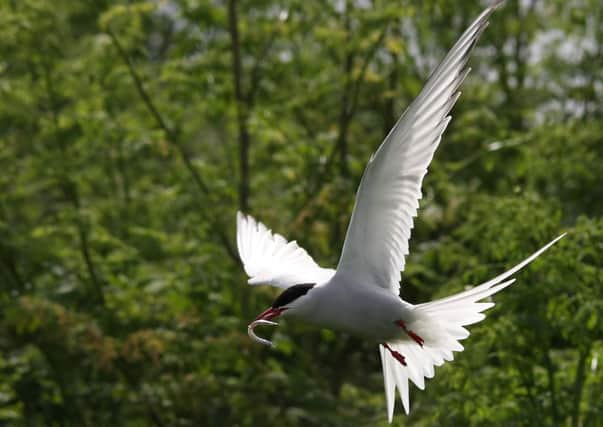Birdwatch: Remarkable migrator with the forked tail


Arctic terns were reported in many places in the region, very similar to the common terns now settling down to breed here.
Both are white and grey birds with a black cap and forked tail but the common tern has a black tip to its orange-red bill while the Arctic tern, pictured, has a blood red bill with no black tip.
Advertisement
Hide AdAdvertisement
Hide AdAlso the Arctic tern has narrower wings and longer streamers on its tail than the common but at a distance it is not always possible to pick these features out and the observer has to settle for seeing a ‘Comic’ tern as a way of covering both possibilities.
Arctic terns have a remarkable migration and experience more daylight hours than any other creature on the planet, spending our summer in the Arctic and winter in the Antarctic.
Scientists from Newcastle University have fitted more than 30 of the 2,000 pairs that nest on the Farne Islands off the Northumberland coast with tiny geo-locators to track their movements.
Last year one was found to have covered the longest migration ever recorded – from the Farnes to the Weddell Sea in Antarctica and back again – a total distance of 59,650 miles. It took four months until November for it to reach Antarctica after travelling down the West African coast, round the Cape of Good Hope and across the Indian Ocean. Then the following March it began the return journey arriving back on the Farnes again in May last year.
Advertisement
Hide AdAdvertisement
Hide AdAs Arctic terns can live as long as 30 years the total distance one must cover during its lifetime is truly amazing.
Another tern species heading in a very different direction, black terns, were also seen in large numbers, on their way back to breeding sites in Poland and Belarus.
They belong to a group called marsh terns and breed on fresh water wetlands, building nests on floating vegetation.
Several sandwich terns were also reported at inland sites, a little tern at Thrybergh country park, South Yorkshire and the first roseate tern of the year at Beacon Ponds, East Yorkshire
Advertisement
Hide AdAdvertisement
Hide AdThere were large numbers of waders on the move along the Yorkshire coast including a broad-billed sandpiper at Spurn. Inland sightings included sanderlings, knot, turnstones, and bar-tailed godwits.
The first dotterels were seen on passage with three at Wainstalls above Halifax and a female at Kilnsea.
The first turtle dove was reported back in Dalby Forest while another was seen at East Lea, Filey.
A male golden oriole was seen briefly at Hatfield Moors on Tuesday.
Advertisement
Hide AdAdvertisement
Hide AdBirders in South and West Yorkshire followed the progress of an immature white-tailed eagle last Saturday. It was first seen at Stainton Quarry near Doncaster, then over Wintersett reservoir and Haw Wood at Angler’s Country Park.